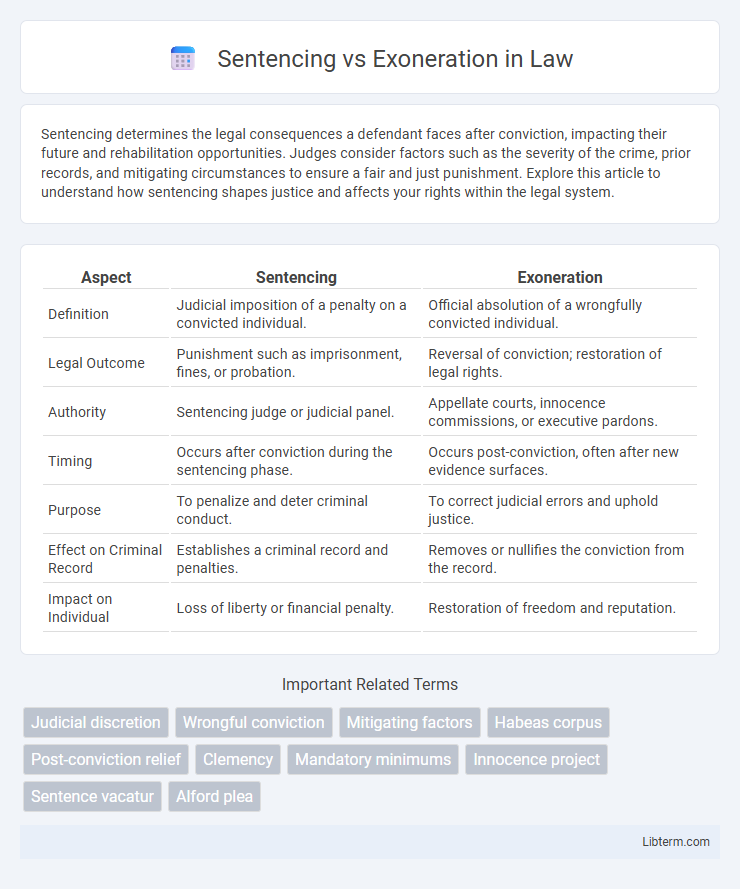Sentencing determines the legal consequences a defendant faces after conviction, impacting their future and rehabilitation opportunities. Judges consider factors such as the severity of the crime, prior records, and mitigating circumstances to ensure a fair and just punishment. Explore this article to understand how sentencing shapes justice and affects your rights within the legal system.
Table of Comparison
| Aspect | Sentencing | Exoneration |
|---|---|---|
| Definition | Judicial imposition of a penalty on a convicted individual. | Official absolution of a wrongfully convicted individual. |
| Legal Outcome | Punishment such as imprisonment, fines, or probation. | Reversal of conviction; restoration of legal rights. |
| Authority | Sentencing judge or judicial panel. | Appellate courts, innocence commissions, or executive pardons. |
| Timing | Occurs after conviction during the sentencing phase. | Occurs post-conviction, often after new evidence surfaces. |
| Purpose | To penalize and deter criminal conduct. | To correct judicial errors and uphold justice. |
| Effect on Criminal Record | Establishes a criminal record and penalties. | Removes or nullifies the conviction from the record. |
| Impact on Individual | Loss of liberty or financial penalty. | Restoration of freedom and reputation. |
Introduction to Sentencing and Exoneration
Sentencing establishes the legal punishment imposed on a convicted individual, reflecting factors such as the severity of the crime, prior criminal history, and statutory guidelines. Exoneration involves the formal clearing of a person's name after evidence proves their innocence, often through DNA testing, new witness testimonies, or procedural errors in the original trial. Understanding the processes of sentencing and exoneration is crucial for ensuring justice and correcting wrongful convictions within the criminal justice system.
Defining Sentencing in the Justice System
Sentencing in the justice system refers to the formal declaration of a punishment imposed on a convicted individual by the court. It serves as a crucial phase following conviction, determining penalties such as imprisonment, fines, probation, or community service based on legal guidelines and case circumstances. This process aims to balance justice, deterrence, rehabilitation, and public safety while reflecting the severity of the offense and criminal history.
Understanding Exoneration: Key Concepts
Exoneration refers to the legal process that officially clears an individual of criminal charges, often after new evidence proves their innocence or reveals procedural errors in the original conviction. Key concepts in understanding exoneration include wrongful conviction, DNA testing, and the role of innocence projects in advocating for the review of cases. Sentencing, by contrast, involves the judicial determination of punishment following a conviction, highlighting the critical impact exoneration has on rectifying miscarriages of justice.
Sentencing Procedures: Steps and Standards
Sentencing procedures involve a sequence of steps including presentence investigations, victim impact statements, and judicial consideration of aggravating and mitigating factors to determine an appropriate punishment within statutory guidelines. Courts apply sentencing standards such as mandatory minimums, sentencing ranges, and sentencing guidelines to ensure consistency and fairness while allowing judicial discretion. These procedures aim to balance public safety, offender rehabilitation, and proportionality of the sentence relative to the crime severity.
Grounds and Processes for Exoneration
Exoneration occurs when new evidence, such as DNA testing or witness recantations, proves a convicted individual's innocence, overriding the original sentencing judgment. Legal processes for exoneration typically involve post-conviction appeals, motions for a new trial, or habeas corpus petitions, often initiated by innocence projects or public defenders. Grounds for exoneration emphasize factual innocence, prosecutorial misconduct, ineffective assistance of counsel, or newly discovered evidence that invalidates the legitimacy of the conviction and sentencing.
Comparing Legal Outcomes: Sentencing vs. Exoneration
Sentencing results in the formal imposition of penalties or punishments following a criminal conviction, while exoneration legally clears an individual of all charges, typically due to new evidence proving innocence. Sentencing impacts a convicted person's rights, freedom, and record, whereas exoneration restores legal status and can lead to compensation for wrongful conviction. The key legal outcome difference lies in sentencing enforcing consequences, whereas exoneration reverses the conviction and acknowledges a miscarriage of justice.
Factors Leading to Wrongful Sentencing
Factors leading to wrongful sentencing often include eyewitness misidentification, unreliable forensic evidence, false confessions, and prosecutorial misconduct. Systemic issues such as inadequate defense representation, racial bias, and flawed judicial procedures also contribute significantly to conviction errors. Advances in DNA testing and investigative reviews have played a crucial role in exonerating wrongfully sentenced individuals.
The Role of Evidence in Sentencing and Exoneration
Evidence plays a crucial role in both sentencing and exoneration, determining the degree of guilt or innocence in criminal cases. In sentencing, strong affirmative evidence supports appropriate punishment aligned with the offender's culpability, while in exoneration, new or previously overlooked evidence can prove innocence and overturn wrongful convictions. Forensic data, eyewitness testimony, and DNA analysis are key types of evidence that directly impact judicial decisions in these processes.
Social and Legal Impacts of Exoneration
Exoneration profoundly affects both social and legal spheres by restoring the reputation and rights of the wrongfully convicted, highlighting systemic flaws within the criminal justice system. Socially, exonerees face challenges reintegrating into society, such as stigma and loss of employment, while legally, exoneration prompts reforms like improved forensic standards and the use of innocence commissions. The growing number of exonerations, often supported by DNA evidence, underscores the importance of legal safeguards to prevent miscarriages of justice and ensure accountability.
Reform and Future Directions in Sentencing and Exoneration
Sentencing reform prioritizes reducing disparities and integrating restorative justice principles to enhance fairness and rehabilitation outcomes. Advances in forensic science and legal standards have increased the accuracy of exonerations, highlighting the need for robust post-conviction review systems. Future directions emphasize technology-driven case evaluations and policy changes to prevent wrongful convictions and promote equitable sentencing frameworks.
Sentencing Infographic

 libterm.com
libterm.com